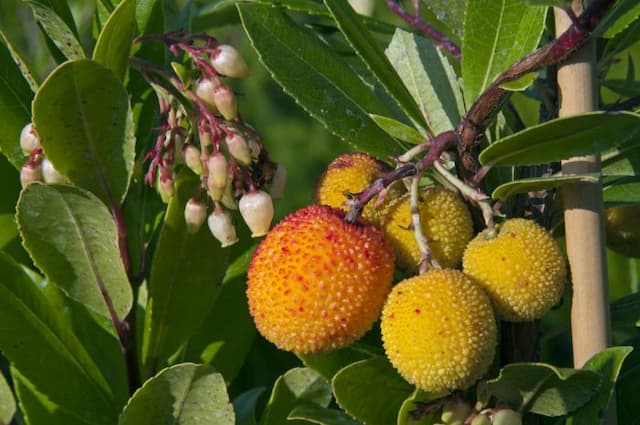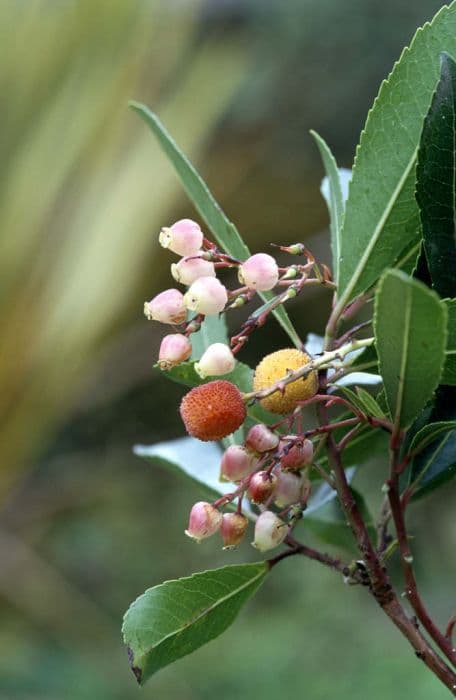Pink Heath Erica mammosa pink-flowered

ABOUT
The plant known commonly as the Pink-Flowered Erica displays a striking visual presence characterized by its vibrant pink blossoms. These blossoms, shaped like small urns or bells, cluster densely at the tips of the branches, creating a lush and colorful display. The flowers' prominent petals, with their delicate shades of pink, range from pale blush to a deeper rose tint, enticing a range of pollinators with their vivid hues and sweet nectar. Complementing these attractive blooms, the foliage of the Pink-Flowered Erica consists of small, needle-like leaves that carry a deep green color, offering a striking contrast against the softness of the petals. These leaves are arranged in whorls along the slender branches, giving the plant a fine-textured appearance that adds to its ornamental appeal. The overall form of the Pink-Flowered Erica is rounded and bushy, with its numerous branches creating a dense and lush silhouette. The plant is well-suited for garden settings, often used for its ornamental value to add pops of color to rockeries, borders, or as part of a mass planting for a more dramatic visual impact. Its captivating beauty draws attention throughout its blooming period, making the Pink-Flowered Erica a beloved choice among garden enthusiasts who wish to incorporate a touch of vibrant pink into their landscapes.
About this plant
 Names
NamesFamily
Ericaceae
Synonyms
Nine-pin Heath, Pink-flowered Erica, Autumn Heath
Common names
Erica mammosa pink-flowered.
 Toxicity
ToxicityTo humans
Ninepin Heath, commonly referred to as Erica mammosa pink-flowered, does not have a well-documented toxicity profile for humans. Many Erica species are not considered highly toxic, but as with any plant, individual sensitivity can vary, and some may experience gastrointestinal discomfort if parts of the plant are ingested. Without specific toxicological data, it is generally recommended to avoid ingesting parts of Ninepin Heath, as the consequences could potentially include nausea, vomiting, or diarrhea due to the unknown compounds that could act as irritants or allergens.
To pets
Ninepin Heath, which is Erica mammosa pink-flowered, is not commonly listed as a toxic plant to pets such as dogs and cats. However, the lack of toxicity reports does not guarantee safety, and ingestion of plant material by pets may lead to gastrointestinal upset, including symptoms like vomiting or diarrhea. Monitoring pets and preventing them from ingesting plants is generally a good precaution, especially when the toxicity of a specific plant is not well established. If a pet does ingest Ninepin Heath and shows any signs of discomfort or illness, it is advisable to contact a veterinarian.
 Characteristics
CharacteristicsLife cycle
Perennials
Foliage type
Evergreen
Color of leaves
Green
Flower color
Pink
Height
3 feet [0.91 meters]
Spread
2 feet [0.61 meters]
Plant type
Shrub
Hardiness zones
9
Native area
South Africa
Benefits
 General Benefits
General Benefits- Aesthetic Appeal: Adds vibrant pink blooms to gardens or landscapes, enhancing overall visual interest.
- Attracts Wildlife: Invites beneficial insects like bees and butterflies, promoting pollination.
- Drought Tolerance: Adapted to survive with minimal water, making it suitable for xeriscaping and drought-prone areas.
- Low Maintenance: Requires little care beyond basic watering and occasional pruning, ideal for gardeners of all levels.
- Year-round Interest: Evergreen shrub that provides structure and color even in cooler months.
- Soil Adaptability: Can thrive in a range of soil types, from acidic to neutral, provided they are well-drained.
 Medical Properties
Medical PropertiesThis plant is not used for medical purposes.
 Air-purifying Qualities
Air-purifying QualitiesThis plant is not specifically known for air purifying qualities.
 Other Uses
Other Uses- Erosion Control: The dense root system of Erica mammosa, also known as nine-pin heath, can help stabilize soil and prevent erosion on slopes.
- Artistic Inspiration: The delicate and intricate flowers of nine-pin heath are often used as subjects or motifs in botanical illustration and nature-inspired artwork.
- Education: Nine-pin heath can be used as an educational tool to teach botany and plant life cycles, specifically in regions where heathlands are part of the natural ecosystem.
- Garden Aesthetics: With its vibrant pink flowers, nine-pin heath can be used to add color and texture to rock gardens and heathland-themed landscapes.
- Hobby Gardening: This plant is prized by hobbyist gardeners for its unique appearance and the challenge it presents in cultivation due to its specific soil and climate requirements.
- Floral Arrangements: The branches of nine-pin heath can be used in dried flower arrangements, providing long-lasting color and form to interior decorations.
- Photography: Nature photographers often seek out nine-pin heath as a subject for practicing macro photography due to its detailed and vibrant flowers.
- Culinary Garnish: Although not consumed, the flowers of nine-pin heath could be used as a non-toxic garnish for culinary dishes, adding a splash of color to presentations.
- Cultural Significance: In areas where nine-pin heath is indigenous, it may have cultural significance and be used in ceremonies or traditional practices.
- Biodiversity Support: Planting nine-pin heath in gardens can help support local biodiversity, providing habitat and food for pollinators such as bees and butterflies.
Interesting Facts
 Feng Shui
Feng ShuiThe plant Erica mammosa pink-flowered is not used in Feng Shui practice.
 Zodiac Sign Compitability
Zodiac Sign CompitabilityThe plant Erica mammosa pink-flowered is not used in astrology practice.
 Plant Symbolism
Plant Symbolism- Endurance: Erica mammosa, commonly known as Pink Heath, is a hardy plant that thrives in challenging environments, symbolizing the ability to endure and persist through hardships.
- Solitude: Pink Heath's natural habitat in isolated locations reflects the symbolism of solitude and the value of self-dependence.
- Good fortune: The vibrant pink flowers of the Pink Heath are often associated with good luck and positive outcomes.
- Protection: In some cultures, Erica plants are believed to offer protection against negative energy, symbolizing a safe haven or shelter.
 Water
WaterNinepin heath, when grown outdoors, requires regular watering to maintain consistent soil moisture, particularly during its growing season in spring and summer. Typically, watering approximately once a week with around 1 gallon of water per plant is a good starting point, but this should be adjusted based on the weather conditions and soil drainage. If grown in containers, check the top inch of soil for dryness every few days and water thoroughly until excess water drains out of the bottom of the pot. In the fall and winter, reduce watering frequency as the plant's growth slows down.
 Light
LightNinepin heath thrives in a spot that receives full sun to partial shade. The ideal location is where the plant gets at least six hours of direct sunlight per day. Be cautious of too much afternoon heat in hotter climates, as it can scorch the foliage, so a spot with morning sun and afternoon shade can be preferable in these areas.
 Temperature
TemperatureNinepin heath, being a hardy plant, can tolerate a temperature range from around 20°F to 85°F. However, the ideal growing temperatures are between 60°F and 75°F. Protection from extreme winter cold or frost may be necessary to prevent damage to the plant.
 Pruning
PruningPruning ninepin heath is done to maintain its attractive shape, encourage bushy growth, and remove dead or spent flowers. It's best to prune after it has finished blooming, usually in late spring or early summer. Cut back the tips of the branches by a few inches, and be careful not to cut into older wood, as this can prevent future flowering. Pruning annually or biennially is often sufficient.
 Cleaning
CleaningAs needed
 Soil
SoilThe best soil mix for Ninepin Heath (Erica mammosa) should be well-draining, acidic, and rich in organic matter. A mixture of peat moss, sand, and pine bark at a ratio of 2:1:1 can provide the appropriate texture and aeration. The soil pH should be in the range of 4.5 to 5.5.
 Repotting
RepottingNinepin Heath should be repotted every two to three years to refresh the soil and provide room for growth. It's best to repot in the spring at the beginning of the growing season.
 Humidity & Misting
Humidity & MistingNinepin Heath prefers moderate to high humidity levels, ideally ranging from 50% to 70%. The plant thrives in a consistently humid environment but can tolerate lower humidity levels if not subjected to dry indoor heating.
 Suitable locations
Suitable locationsIndoor
Place in bright, indirect light with acidic soil mix.
Outdoor
Plant in dappled shade, acidic soil, ensure good drainage.
Hardiness zone
7-9 USDA
 Life cycle
Life cycleErica mammosa, commonly known as the Nine-pin Heath, begins its life as a seed that requires well-drained acidic soil and exposure to sun or partial shade to germinate. The seedling stage involves the establishment of roots and the emergence of juvenile leaves as it develops into a young plant. In the vegetative stage, the plant exhibits bushy growth, producing needle-like leaves and branching stems. Over the years, as it matures, the Nine-pin Heath enters the flowering stage, typically producing its characteristic pink blooms during the late winter to spring season. After pollination, flowers develop into seed-containing capsules that eventually dry and release seeds, completing the reproductive cycle. The plant can live for several years, with some mature specimens reaching up to 10 years of age, continuing the cycle annually as long as conditions are favorable.
 Propogation
PropogationPropogation time
Spring to Summer
The pink-flowered form of Erica mammosa, commonly known as Pink Heath, is predominantly propagated through semi-hardwood cuttings. The best time to do this is in late summer or early autumn when the plant's growth begins to slow. A healthy, disease-free shoot is selected, and a cutting of about 4 to 6 inches (10 to 15 centimeters) is taken. The lower leaves are then stripped, and the cut end can be dipped in rooting hormone to encourage root development. The cutting should be placed in a well-draining medium like a mixture of peat and perlite and kept moist but not waterlogged. It's important to provide a warm environment and, if possible, bottom heat to promote rooting. Cuttings typically root in 6 to 10 weeks, after which they can be transplanted into individual pots to grow on before being planted out.









